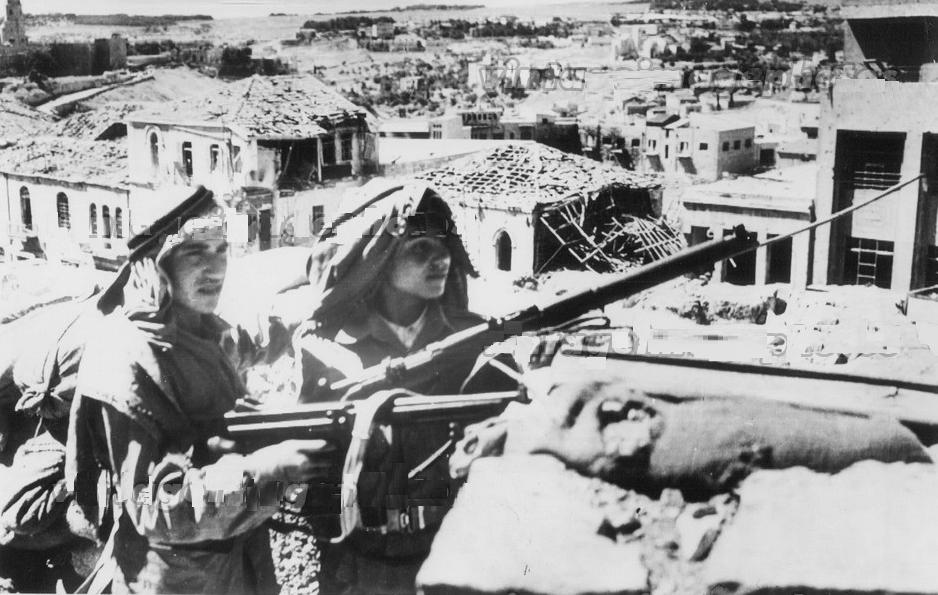
Palestine: The West Bank and Jerusalem (1949-67)

Figure 1.--Here we see youthful Jordanians on the casefire line in East Jerusalem during 1953. The caption read, "Jerusalem: Arab guards keep watch from their station on the wall by the Jaffa Gate of the Old City of Jerusalem. Radio Damascus repoted 10/21 that Iraqi and Syrian troops are moving to the city to reinforce Jordan's crack Arab Legion in the Jordanian-held part of the city. The troop movement was announced as the powerful political committee of the 7-nation Arab League met in Amann, Jordan, to discuss complaint of 'Jewish Agression'. We have no idea what agression they are referring to, but believe it was simply that the Isrealis held a portion of Palestine. Notice the destruction in the background. We are not sure what force the youths belong to. I do not know if they were part of the Arb Legion which was to be converted to the Jordanian Army.
|
|
The Jordanian English-trained and led Arab Legion was small, but the most effective Arab fighting force. The Arab Legion seized the the Old City of Jerusalem and took control of territory on the western side of the Jordan River, including the cities of Jericho, Bethlehem, Hebron and Nablus. When the Jordan-Israel armistice was signed, the West Bank and East Jerusalem--an area of about 2,100 square miles--came under Jordanian rule (April 3, 1949). Rather than creating a Palestinian state, the half-million Transjordanians were joined by almost half a million more Palestinian Arabs. Unlike the other Arab countries to which Palestinians fled after the 1948 Arab-Israeli War, Palestinian refugees in the West Bank and East Jerusalem as well as the East Bank were given full Jordanian citizenship. Many of the refugees well after the War continued to live in camps and survived on UNRWA assistance. It is important to realize that it was not Israel that prevented the creation of a Paistinian state based on the West Bank, but the Jordanians. This West Bank and East Jerusalem territory was formally annexed by the Kingdom (April 1950). Israel and Britain had tacitly agreed to Abdullah keeping the area, but the Arab countries and most of the world opposed the King's unilateral action. Only Britain and Pakistan recognized the annexation. The incorporation of the West Bank, with 400,000 Palestinians, into Jordan, as well as a large refugee population that, on the whole, was hostile to the Hashemite regime, brought with them severe economic and political consequences. On the other hand, Abdullah did gain the Muslim shrines such as the Dome of the Rock in Jerusalem's Old City, which compensated in dynastic terms for his father's loss of Mecca and Medina at the hands of Ibn Sa'ud a generation earlier. Access to holy sites ofthe three Abrahamic religions became a major issue after the ceasfire. Jordan had committed itself within the framework of the April 3, 1949 Armistice Agreement to permit 'free access to the holy sites and cultural institutions and use of the cemeteries on the Mount of Olives'." Jordan did allow Christian pilgrims to visit the Temple Mount. Jews on the otherhand, whatever their nationality were prohibited from visiting the Jordanian held holy sites. Tourists entering East Jerusalem had to have baptismal certificates or other proof they were not Jewish. The 1949 framework was to set up a Special Committee to arrange and overseee visits to holy places. The Committeee was, however, never formed. All Israelis, whatever theircreligion, were prohiobited from entering the Old City and other holy sites. [Gilbert, p. 254.] The Jordaniand respected Christian sites, but systematically destroyed the Jewish Quarter and its ancient synagogues. The Arab Legion used gravestones from the Jewish Cemetery on the Mount of Olives to build latrines for army barracks. [Oren, p. 307.]
Sources
Gilbert, Martin. Jerusalem in the Twentieth Century (Pimlico, 1996).
Oren, M. Six Days of War.
HBRC

Navigate the Boys' Historical Clothing Web Site royal pages:
[Return to the Main Jordanian King Abdukah page]
[Return to the Main Jordanian royal page]
[Return to the Main Arab-Isreali 20th century conflict page]
[Return to the Main independent Jordanian history page]
[Return to the Main royal pages]
[Austria]
[Belgium]
[Denmark]
[France]
[Germany]
[Italy]
[Japan]
[Luxenburg]
[Monaco]
[Netherlands]
[Norway]
[Romania]
[Russia]
[Spain]
[United Kingdom]
[Yugoslavia]
Created: 1:04 AM 6/7/2013
Last updated: 1:04 AM 6/7/2013



